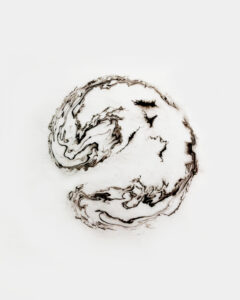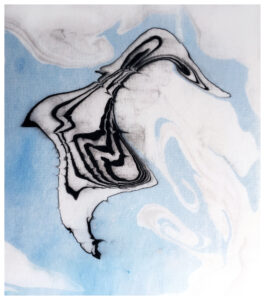Washed Out to Sea: Island Life in Peril
By Tilan E. Copson
School of Policy and International Affairs
University of Maine

The storm hit us in the afternoon and by nightfall the anchor was dragging. Through relentless sheets of rain, I watched my brother climb into the heaving dingy and maneuver the Danforth anchor out of my sister’s straining arms. She climbed in with him and they began pulling along the hull to the anchor line. Powerful gusts of wind came in prolonged and unforgiving blasts. I remember the feeling of deep fear when I lost sight of them, as they moved out into the pitching waves to set the second anchor.
Hurricane Eloise was just another storm passing through Puerto Rico in 1975, one of dozens our family lived through over a thirty-year period. Seven of us, five kids and our parents, lived on a sturdy Cheoy Lee yawl made in Hong Kong. Transplants from Massachusetts and Vermont, my parents lived out a rare dream, raising us on a floating house in the Caribbean. The ocean was home for us, and the island was our lifeline.
We had a fairly good process for dealing with severe weather events, but a storm like Hurricane Maria would have presented a serious challenge. Fueled by the effects of climate change, the severity of the storm was staggering. Puerto Ricans are passionate, fun-loving people, undeserving of the awkward government that normally forms their leadership. They were catastrophically unprepared for the challenges brought about by such a harsh weather event. In reality, no one could have been prepared. Final estimates place the number of deaths due to Hurricane Maria at 3,059, with 2,975 of those in Puerto Rico. Regarded now as the worst natural disaster to hit the area, recovery costs are estimated at over $130 billion.
Puerto Rico has its own lifeline as an unincorporated U.S. territory. Independent island nations all over the world, however, do not enjoy the support of such a powerful country. With limited resources, they are more heavily impacted by small changes in their ecosystems and biospheres. Rising sea levels, floods, droughts, ocean acidification, and more extreme weather events result in compromised water sources, moving fishing grounds, and increased salinization of arable land, as encroaching waters threaten to consume low lying coastal areas.

Extreme weather events, which are happening at an increased frequency all over the world, can consume entire islands, as in the case of Hawaii’s 11-acre East Island. Hurricane Walaka was just one storm during 2018’s unusually busy hurricane season, yet it wiped the island off the map overnight. If I learned anything from my early days on our sailing boat, it would be to respect the weather and never underestimate a storm.
Some island populations have started to prepare and some have already suffered consequences in profound ways. Tuvalu is a series of nine islands in the Pacific Ocean. Coastal erosion and slowly rising tidal waves are threatening two of their islands, which rise just under ten feet above sea level. Tuvalu is not alone. The large number of islands around the world threatened by climate change is surprising. The Maldives, Nauru and the Marshall Islands are just a few island nations actively dealing with rising sea levels, extreme storms, and other climate change-driven effects. These nations have begun to understand their painful interdependency as members of a single planetary climate.
I reflect frequently on my experience living on the ocean. Both boats and islands can suffer the same fate in extreme weather. But by nature, boats have the capacity to move easily and seek out more sustaining lifelines. Island nations are not so lucky, and they frequently suffer their fate with little assistance. Instead, residents must watch helplessly as their homes, their cultural heritage and the only life they have ever known, are slowly swallowed by the sea, while the rest of the world goes about its business.
Here in Maine, many of us weather our storm-related power outages with the warm comfort of wood stoves and the convenient flick of the power button on the generator. We worry tirelessly about our forest health, the warming Gulf waters, and the responsibilities we owe our Arctic north. Despite this, and unlike residents of the world’s many island-based cultures, we simply will not suffer the dramatic loss of our entire culture or watch land disappear from underfoot without recourse.

There are over 4,600 islands off the Maine coast, many of which are essential habitats for unique and beautiful wildlife. According to the Natural Resources Council of Maine, the effect of rising sea levels here in our state will certainly be dramatic. Vinalhaven, the largest island in Penobscot Bay, spans over 14 thousand acres and boasts a rich history in granite production and lobstering. Estimates project a loss of 8% of landmass from a 1-meter sea-level rise and a staggering 23% from a rise of 6 meters. Deer Isle and the Cranberry Isles will see roughly half that, at 4% and 5% respectively, from a 1-meter sea-level rise. Given that sea levels are rising at an increasing rate, it is tough to predict exactly how much time these communities have to prepare, but for other island communities around the world, time has run out.
It would seem that island nations have already figured out our global interconnectedness, while we remain frustratingly ignorant. English poet John Donne famously wrote in his poem “Meditation XVII”, “No man is an island, entire of itself; every man is a piece of the continent, a part of the main.” If only this piece of 17th century wisdom could help us understand what island people already know, that we are inevitably linked, if not by land, then certainly by our oceans.
About the Author and Artist
Tilan Copson is a graduate student in the School of Policy and International Affairs, studying roles and responsibilities in the climate change crisis, from a global justice perspective.
The artwork presented here was created using the ancient art of suminagashi where ink is floated on water and “lifted” onto paper.
“As a researcher and artist, I seek out ways to share my experiences and build cohesion in the face of climate change. Floating ink (the literal translation of the Japanese term “suminagashi”) on water can create effects that vary greatly. By layering ink across the surface of water, it is possible to mimic scenes depicting tree rings, topological maps or islands surrounded by moving currents. Controlling the ink carefully results in floating shapes, ethereal and isolated, as unique as any natural form. In this series of prints, the floating ink process is used as a metaphor for the relationship between land and water. I am always trying to find ways to share my perspective of how beautiful yet fragile our relationship with the sea can be.”

